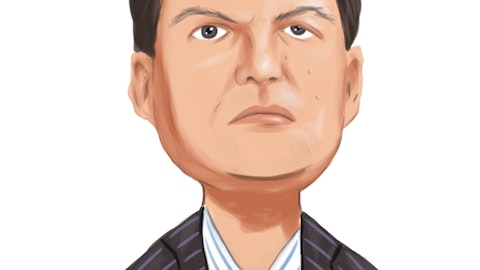Rati Levesque: So I’ll start with your last question first. Out-of-policy returns because that’s an easy one. We’re not seeing any changes there at this time, so pretty flat, to what we’ve seen in in the past as far as historic numbers go. The first question on less units coming through, are you seeing less efficiencies? No. We are not seeing less efficiencies in specifically our operations, and I’m talking about and that’s because a lot of what we did and a lot of the investments, like Robert mentioned earlier, was around, accelerating operations their efficiencies. Transportation, you’ve heard us talk about carrier diversification. All of that is coming into a fruition. Inventory control making sure that we’re getting tighter about each item coming through the process, also adding efficiency.
So just making things a little bit tighter throughout the process.So we really feel good about the direction and the impact that we’ve had there with our investments and then as far as on the macro, piece, and I’ll let Koryl and Robert add in, as far as the prudent kind of guidance. So it’s a little bit of a mix as far as what we’re seeing, on buyer behavior. First of all, I want to say supply is really healthy and good. We always said we were a supply constrained business. That is solid right now, and we’re feeling really good about where we’re going there. The consumer is quite healthy in buying jewelry, watches, handbags that mark key product. So that is good news. Where we are seeing some softness is in ready to wear. So it’s kind of a category specific answer, and we’re seeing the consumer be a little bit more promotion, kind of sensitive to that.
So we’re watching for that and again, nothing that we’re alarmed about, but we think it’s the right thing to do to be kind of prudent in our guidance.
Robert Julian: Yes. No, I think it’s a real opportunity. Honestly, Edward, for us to like, we were a lot more precise in the promotions we were running to juice supply. When we made the commission changes, we really saw a pullback not only in low value, but we also had some softness and some mid value. So we got a little bit promotional there. We have a little bit of a blunt instrument approach. We’re a lot more surgical now talking to specific customers about specific actions and with that capability, it was built in such a way that when we’re building the personalization, we can use the exact same personalization capabilities to solicit demand. So you haven’t heard us talk about demand much, not at all since I’ve been here, where we’ve always talked about being a supply constrained business now.
There are certain elements in certain categories and certain price points where we actually do have to adjust our prices, right, and where we do have to actually become a little bit more promotional but the good news is we have a very large pool of members to draw from, and we can actually see a lot of their behavior, even in the absence of transactions, we can see many people who are obsessing certain products, how many people are visiting the site on a regular basis. We’re observing all those macro and micro trends together to see what we have to see what we have to do to make sure that we keep the throughput going through the business at the right pace.
Edward Yruma: Maybe just as a follow-up to that, does that mean you’re adjusting kind of the payouts? I mean, not the grid obviously, but kind of what you initially expect to pay out to the, consignors?
Robert Julian: When we had to be a little bit more promotional to drive supply earlier in the year, we had some promotional activity there. This is more on the actual buyer side now. So to reinitiate a lapsed customer, to get somebody to buy in a category that they haven’t bought before, that’s the type of promotions I’m talking about Edward.
Operator: Our next question comes from Ashley Owens from KeyBanc Capital Markets.
Ashley Owens: Hi. Thanks for taking the question. Just wanted to ask about marketing dollars as they came down during the quarter. Was this an intentional pullback or did you see some efficiencies? And then just any color on how we should think about the rate going forward would be helpful as well.



